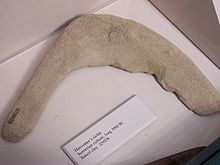This article is about the introduction of agriculture during the Stone Age. For later historical breakthroughs in agriculture, see Agricultural revolution (disambiguation).
The Neolithic Revolution or Neolithic Demographic Transition, sometimes called the Agricultural Revolution, was the wide-scale transition of many human cultures from a lifestyle of hunting and gathering to one of agriculture and settlement, allowing the ability to handle an increasingly larger population.[1] These settled communities permitted humans to observe and experiment with plants to learn how they grew and developed.[2] This new knowledge led to the domestication of plants.[2]
Archaeological data indicates that the domestication of various types of plants and animals evolved in separate locations worldwide, starting in the geological epoch of the Holocene[3] around 12,500 years ago.[4] It was the world's first historically verifiable revolution in agriculture. The Neolithic Revolution greatly narrowed the diversity of foods available, with a switch to agriculture which led to a downturn in human nutrition.[5]
The Neolithic Revolution involved far more than the adoption of a limited set of food-producing techniques. During the next millennia it would transform the small and mobile groups of hunter-gatherers that had hitherto dominated human pre-history into sedentary (non-nomadic) societies based in built-up villages and towns. These societies radically modified their natural environment by means of specialized food-crop cultivation (e.g., irrigation and deforestation) which allowed extensive surplus food production.
These developments provided the basis for densely populated settlements, specialization and division of labour, trading economies, the development of non-portable art andarchitecture, centralized administrations and political structures, hierarchical ideologies, depersonalized systems of knowledge (e.g., writing), and property ownership[citation needed]. Personal land and private property ownership led to hierarchical society, an elite Social class,[6] comprising a nobility, polity, and military.[citation needed] The first fully developed manifestation of the entire Neolithic complex is seen in the Middle Eastern Sumerian cities (c. 5,500 BP), whose emergence also heralded the beginning of the Bronze Age.
The relationship of the above-mentioned Neolithic characteristics to the onset of agriculture, their sequence of emergence, and empirical relation to each other at various Neolithic sites remains the subject of academic debate, and varies from place to place, rather than being the outcome of universal laws of social evolution.[7][8] The Levantfollowed by Mesopotamia are the sites of the earliest developments of the Neolithic Revolution from around 10,000 BC. It has been identified as having "inspired some of the most important developments in human history including the invention of the wheel, the planting of the first cereal crops and the development of cursive script, mathematics,astronomy and agriculture.

0 comments:
Post a Comment